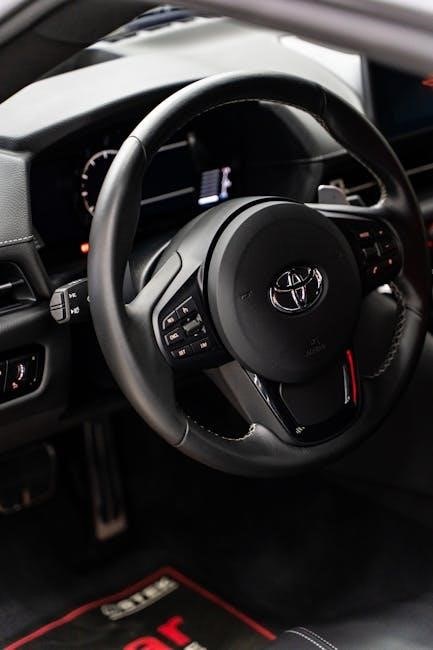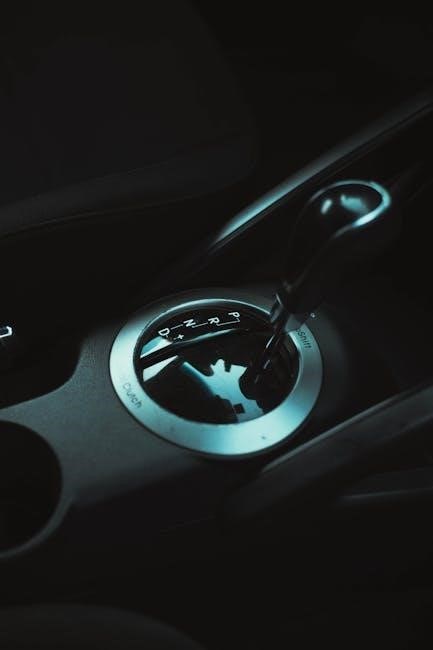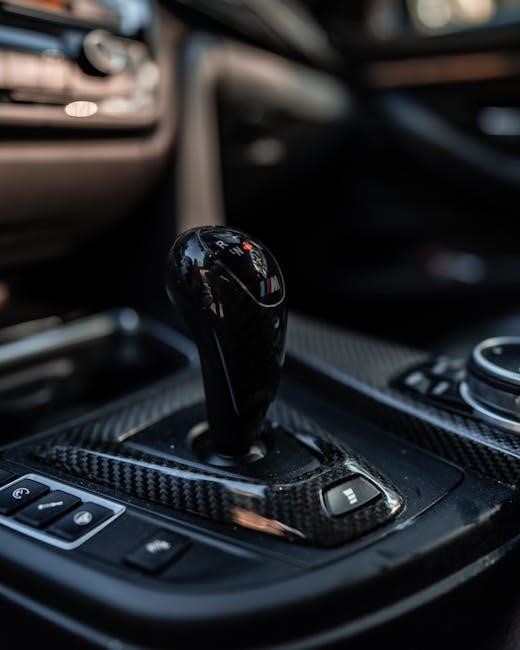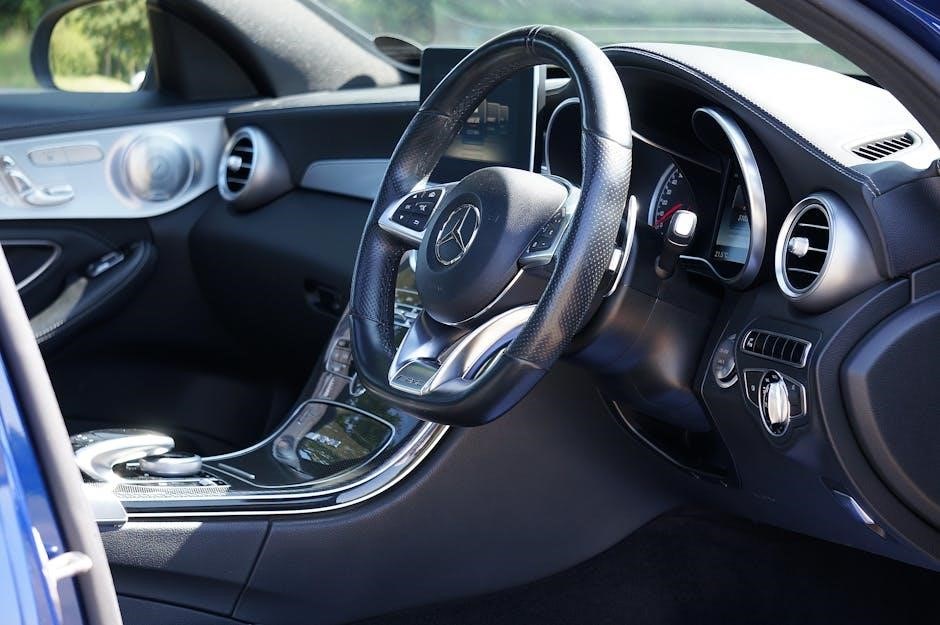
how to convert automatic to manual
Converting an automatic transmission to manual offers enhanced driving control and performance but requires careful planning and mechanical expertise for a successful swap.
Why Convert from Automatic to Manual?
Converting from automatic to manual transmission offers several benefits, including enhanced driving control, improved performance, and a more authentic driving experience. Many enthusiasts prefer manual transmissions for the direct connection to the vehicle and the ability to optimize gear shifts. Additionally, manual transmissions often provide better fuel efficiency and lower long-term maintenance costs compared to automatics. For vintage or high-performance vehicles, a manual conversion can restore original driving characteristics or elevate performance capabilities. The satisfaction of mastering a manual gearbox is another compelling reason, as it engages the driver more actively in the driving process. This conversion is not just about the transmission but also involves integrating a clutch system and reprogramming the ECU for seamless functionality. Ultimately, it’s a significant enhancement for those seeking a more immersive and rewarding driving experience.
Understanding the Basics of Manual and Automatic Transmissions
A manual transmission relies on a driver-operated clutch pedal and gearshift to change gears, offering precise control. An automatic transmission uses a torque converter and hydraulic systems to shift gears automatically, minimizing driver input. Both systems aim to optimize engine performance and vehicle speed but differ in operation and driver engagement. Manual transmissions typically have fewer components, making them lighter and more fuel-efficient. Automatics, while convenient, often weigh more and consume more fuel. Understanding these basic differences is crucial for evaluating the feasibility of a conversion and ensuring compatibility between components. This foundational knowledge helps in making informed decisions during the conversion process, ensuring a smoother transition from automatic to manual.

Assessing Feasibility for Conversion
Evaluate vehicle compatibility, as only certain models with existing manual versions can be converted. Ensure parts availability and budget for the process, requiring specialized tools and expertise.
Can Your Car Be Converted?
Not all cars are suitable for automatic-to-manual transmission conversion. Compatibility depends on the vehicle’s make, model, and whether a manual version was originally available. If your car was never offered with a manual transmission, the process becomes more complex and may require custom fabrication or extensive modifications. Check manufacturer specifications to confirm if a manual transmission was an option for your vehicle. Additionally, assess the availability of compatible parts, such as the transmission itself, clutch system, and pedals. Some modern vehicles with advanced electronic systems may also require specialized reprogramming. Consult with experts or forums to determine feasibility for your specific car before proceeding.
Cost Considerations for the Conversion
Converting an automatic to a manual transmission can be costly, with prices ranging from $2,000 to $5,000 or more, depending on the vehicle and complexity. The primary expenses include the manual transmission itself, clutch system, pedal assembly, and labor if hiring a mechanic. Additional costs may arise from custom fabrication or ECU reprogramming. High-performance or rare parts can significantly increase the budget. Shop around for parts and consider used or refurbished components to reduce expenses. Labor costs vary widely, so compare quotes from trusted mechanics. Be prepared for unexpected fees, such as transmission mounting or drivetrain adjustments. Budgeting carefully and planning ahead is crucial for a successful conversion.
Tools and Resources Needed
Converting an automatic to a manual transmission requires a well-equipped toolkit and access to specialized resources. Essential tools include a hydraulic jack, transmission jack, wrenches, sockets, and a clutch alignment tool. A service manual for your specific vehicle is crucial for guidance. Additionally, diagnostic tools may be needed for ECU reprogramming. Online forums and specialist communities can provide valuable insights and troubleshooting tips. If inexperienced, consulting a professional mechanic or transmission specialist is advisable. Ensure all components are compatible and sourced from reliable suppliers; Proper workspace setup, including a drain pan and safety gear, is also necessary for a smooth process.

Preparation for the Conversion Process
Begin by assessing your vehicle’s compatibility and gathering necessary tools and parts. Plan the workspace and schedule, ensuring all components are compatible and readily available for a smooth transition.
Gathering Necessary Parts and Components
Gathering the right parts is crucial for a successful conversion. Start by sourcing a compatible manual transmission, clutch system, and pedal assembly. Ensure the transmission matches your vehicle’s make and model for proper compatibility; Additionally, acquire a flywheel, pressure plate, and clutch disc specifically designed for your engine type. Don’t forget to collect mounting hardware, such as transmission mounts and crossmembers, to secure the new unit. If your vehicle didn’t originally come with a manual option, you may need to fabricate or source custom components. Always verify compatibility and consult factory manuals or specialists to avoid costly mistakes. Proper planning ensures a smoother installation process.
Sourcing Manual Transmission Parts
Sourcing the right manual transmission parts is essential for a smooth conversion. Start by identifying a compatible manual transmission that fits your vehicle’s make and model. Consider purchasing from reputable suppliers, salvage yards, or online retailers specializing in transmission components. Key parts include the transmission itself, clutch assembly, flywheel, and linkage. Ensure all components are compatible with your engine and drivetrain. For rare or custom setups, consult specialists or forums for guidance. Verify the condition of used parts to avoid future issues; Additionally, gather necessary hardware like bolts, bearings, and seals. Proper sourcing ensures a seamless installation and optimal performance. Always cross-reference parts with your vehicle’s specifications to guarantee compatibility.
Setting Up Your Workspace
Setting up a well-organized workspace is crucial for a successful transmission conversion. Start by designating a clean, flat, and well-lit area to work in. Gather all necessary tools, such as wrenches, screwdrivers, and socket sets, and ensure they are within easy reach. Use a sturdy hydraulic hoist or jack stands to safely lift and support the vehicle. Protect yourself with gloves, safety glasses, and a dust mask. Organize the parts you’ll be removing and installing by labeling them clearly. Consider using a parts organizer or storage bins to keep components tidy. Finally, ensure proper ventilation and have a drain pan ready for any fluids that may leak during the process. A well-prepared workspace minimizes delays and reduces the risk of errors.

Understanding the Mechanical Process
Converting from automatic to manual involves removing the automatic transmission, installing a manual gearbox, and setting up the clutch system, ensuring proper alignment of the driveshaft and components.

Removing the Automatic Transmission
Removing the automatic transmission is a critical step in the conversion process. Begin by disconnecting the battery to prevent electrical issues. Drain the transmission fluid and disconnect the cooler lines, transmission pan, and electrical connectors. Raise the vehicle and remove the crossmember and heat shield for access. Detach the transmission mounts and carefully pull the transmission straight back, ensuring the torque converter is properly secured. Finally, remove the transmission bolts and lift the automatic transmission out using a jack or transmission jack. This step requires precision to avoid damaging surrounding components or the engine.
Installing the Manual Transmission
Installing the manual transmission requires careful alignment and precision. Once the automatic transmission is removed, position the manual transmission into place, ensuring it aligns with the engine’s bellhousing. Secure the transmission using the appropriate bolts, tightening them evenly to avoid warping the mounting surface. Reattach the transmission mounts and crossmember for stability. Connect the driveshaft to the manual transmission, ensuring it is properly seated and secured. Reinstall any heat shields or protective covers removed during the process. Finally, reconnect the electrical connectors and bleeding the clutch system to ensure proper function. This step is crucial for ensuring smooth operation of the manual gearbox.
Setting Up the Clutch System
Setting up the clutch system is a critical step in the manual transmission conversion process. Begin by installing the clutch pedal assembly, ensuring it is securely mounted and properly aligned. Next, connect the hydraulic clutch master cylinder to the slave cylinder, making sure all lines are free from leaks. The clutch disc and pressure plate must be installed on the flywheel, ensuring they are centered and evenly spaced. Finally, bleed the hydraulic system to remove any air bubbles, which can cause spongy pedal feel or poor engagement. Properly tension the clutch cable or linkage, if applicable, and test the clutch operation to ensure smooth engagement and disengagement before driving the vehicle.

Electrical and Mechanical Modifications
Modify the ECU for manual transmission recognition, install a clutch pedal, and align the transmission with the driveshaft to ensure proper mechanical and electrical functionality.
ECU Reprogramming for Manual Transmission
ECU reprogramming is essential for manual transmission conversion, ensuring the engine computer recognizes the new gearbox. This process involves updating software to disable automatic-specific controls and enable manual shift detection. Without proper reprogramming, the vehicle may experience issues like incorrect gear recognition or torque converter engagement. Professional tuning is recommended to adapt the ECU for manual operation, especially if the vehicle originally had an automatic transmission. This step ensures seamless communication between the engine and transmission, optimizing performance and drivability. Failure to reprogram the ECU can lead to operational problems, making it a critical part of the conversion process.
Installing a Clutch Pedal and Linkage
Installing a clutch pedal and linkage is a critical step in converting to a manual transmission. Start by removing the driver’s seat and automatic pedals to access the area. Drill holes for the clutch pedal assembly and mount it securely. Ensure proper alignment with the transmission linkage to maintain smooth operation; Use high-quality components, such as a billet clutch pedal, for durability. The linkage must be adjusted precisely to avoid mechanical binding or inconsistent clutch engagement. While challenging, this step is essential for enabling manual gear shifts and restoring driver control over the vehicle’s performance.
Aligning the Transmission and Driveshaft
Aligning the transmission and driveshaft is crucial for proper power transfer and to prevent mechanical damage. After installing the manual transmission, ensure the driveshaft is correctly connected and aligned with the transmission’s output shaft. Measure and verify the driveshaft length to match the new manual setup, as it may differ from the automatic configuration. Use a dial indicator or alignment tool to check for any misalignment. If necessary, adjust the transmission mounts or driveshaft yoke to achieve proper alignment. A misaligned driveshaft can cause vibrations, wear on components, or even failure during operation. Ensure all connections are secure and test the system at low speed before full operation.

Final Steps and Testing

After conversion, test the manual transmission thoroughly. Bleed the clutch system to remove air, check for leaks, and ensure smooth gear shifts and proper engagement.
Bleeding the Clutch System
Bleeding the clutch system is essential to ensure proper engagement and eliminate air bubbles in the hydraulic lines. Use a clutch bleeding kit and follow manufacturer instructions.
Pump the clutch pedal several times to pressurize the system, then open the bleeder valve to release air and fluid. Repeat until fluid flows without bubbles.
Ensure the reservoir remains filled with the correct type of brake fluid to avoid contamination. Inspect for leaks and test the pedal feel to confirm success.
This step guarantees smooth clutch operation and prevents premature wear on components. Proper bleeding ensures reliable performance after the manual transmission conversion.
Testing the Manual Transmission
Testing the manual transmission ensures proper functionality after conversion. Start with a slow drive in a controlled environment to assess smooth shifting and clutch engagement.
Check for any grinding or slipping during gear changes, as this indicates potential issues with the clutch or alignment. Ensure the transmission engages each gear cleanly.
Monitor acceleration and deceleration to confirm seamless operation. If shifting feels irregular, inspect the clutch system and transmission mounts for proper installation.
A successful test confirms the conversion’s success and readiness for everyday use. Proper testing ensures reliability and performance, validating your manual transmission upgrade.
Ensuring Proper Functionality
After installing the manual transmission, ensuring proper functionality is critical for reliable performance. Begin by verifying the clutch system operates smoothly, with consistent pedal feel and full engagement.
Check transmission mounts for stability and alignment to prevent vibration or misalignment issues. Inspect the driveshaft and couplers for secure connections to avoid power loss.
Test the gearshift mechanism to ensure precise and effortless shifting across all gears. Address any unusual noises or resistance immediately to prevent damage.
A professional inspection can identify potential issues early, ensuring long-term reliability. Proper functionality guarantees a smooth and enjoyable driving experience with your new manual setup.

Post-Installation Considerations
After conversion, ensure legal compliance and safety inspections are completed. Address any ECU reprogramming needs and verify compatibility with existing systems for optimal performance and reliability.
Adjusting to Manual Transmission Driving
Transitioning to a manual transmission requires practice to master clutch control and smooth shifting. Start in an empty parking lot to avoid traffic stress. Gradually ease off the clutch while pressing the accelerator to avoid stalling. Practice shifting through all gears to develop muscle memory. Pay attention to engine RPMs to determine optimal shift points. Avoid “riding the clutch,” as this can cause wear. Over time, you’ll become more comfortable with the rhythm of shifting and clutch engagement. Consistent practice will enhance your driving skills and make manual transmission operation second nature. Patience is key to enjoying the precise control a manual transmission offers.
Maintenance Tips for the New Manual Transmission

Regular maintenance is crucial for the longevity of your manual transmission. Check the transmission fluid level regularly and top it off as needed to ensure proper lubrication. Replace the fluid every 30,000 to 60,000 miles, depending on your vehicle’s specifications. Inspect the clutch system for wear and tear, especially the clutch disc and pressure plate. Replace worn-out components promptly to avoid costly repairs. Lubricate the shift linkage and clutch pedal periodically to maintain smooth operation. Monitor for unusual noises or vibrations, as they can indicate impending issues. Adhering to a consistent maintenance schedule will help prevent breakdowns and keep your manual transmission running smoothly for years.
Legal and Safety Inspections
After converting to a manual transmission, ensure your vehicle passes all legal and safety inspections. Check local regulations regarding transmission swaps, as some jurisdictions may require documentation or certifications. Inspect the clutch system, pedals, and linkages for proper function and safety. Verify that all electrical components, including the ECU, are correctly integrated and functioning. Test the vehicle’s braking system to ensure it operates seamlessly with the new manual setup. Schedule a professional inspection to confirm compliance with safety standards. Address any issues promptly to avoid legal penalties and ensure your vehicle is roadworthy. Compliance and safety are paramount to enjoy your manual transmission without worries.